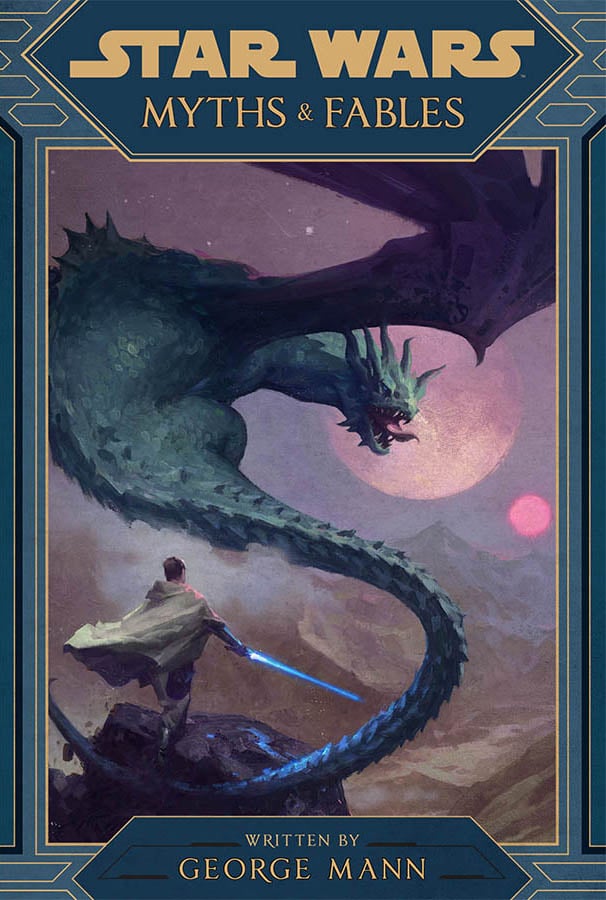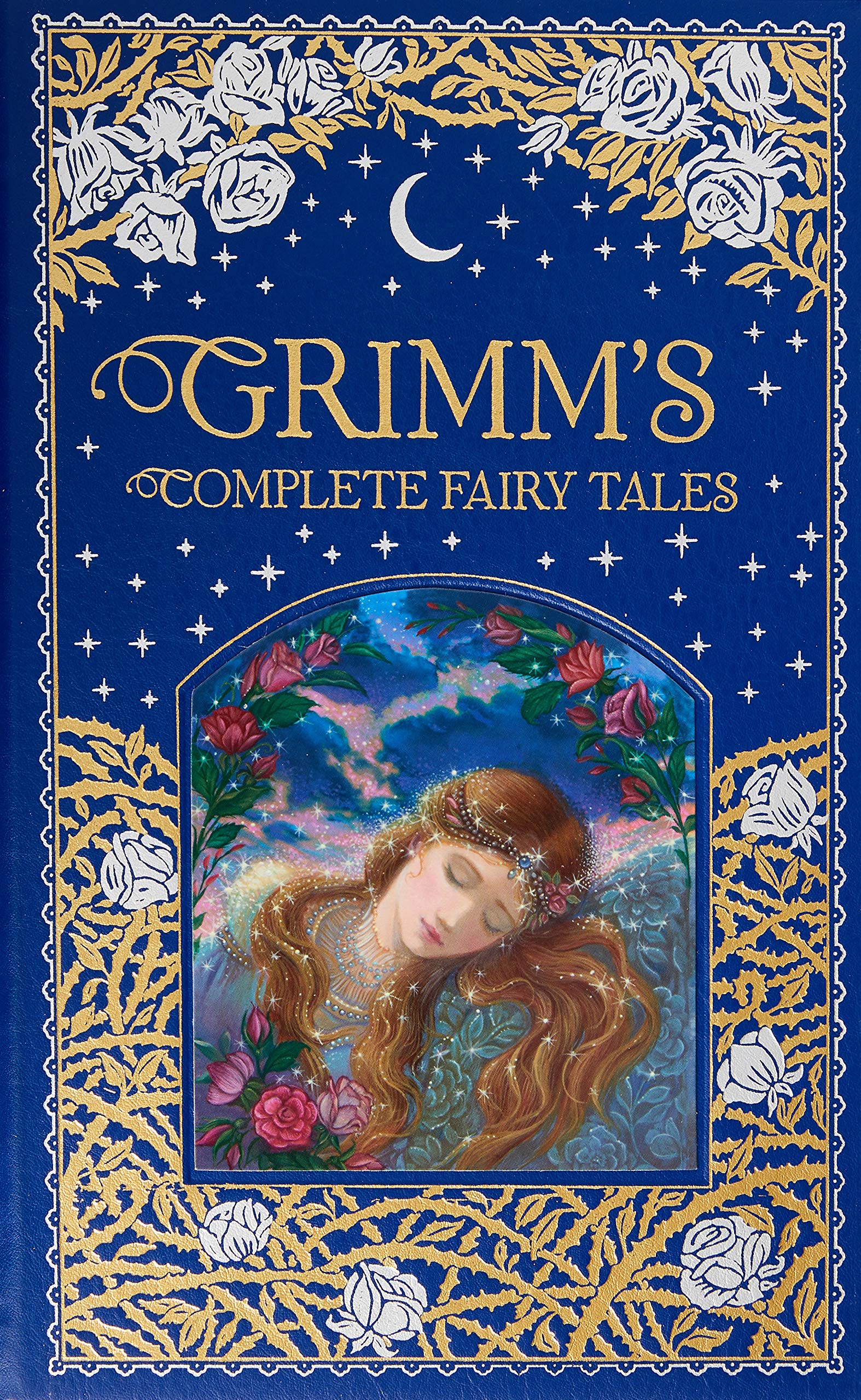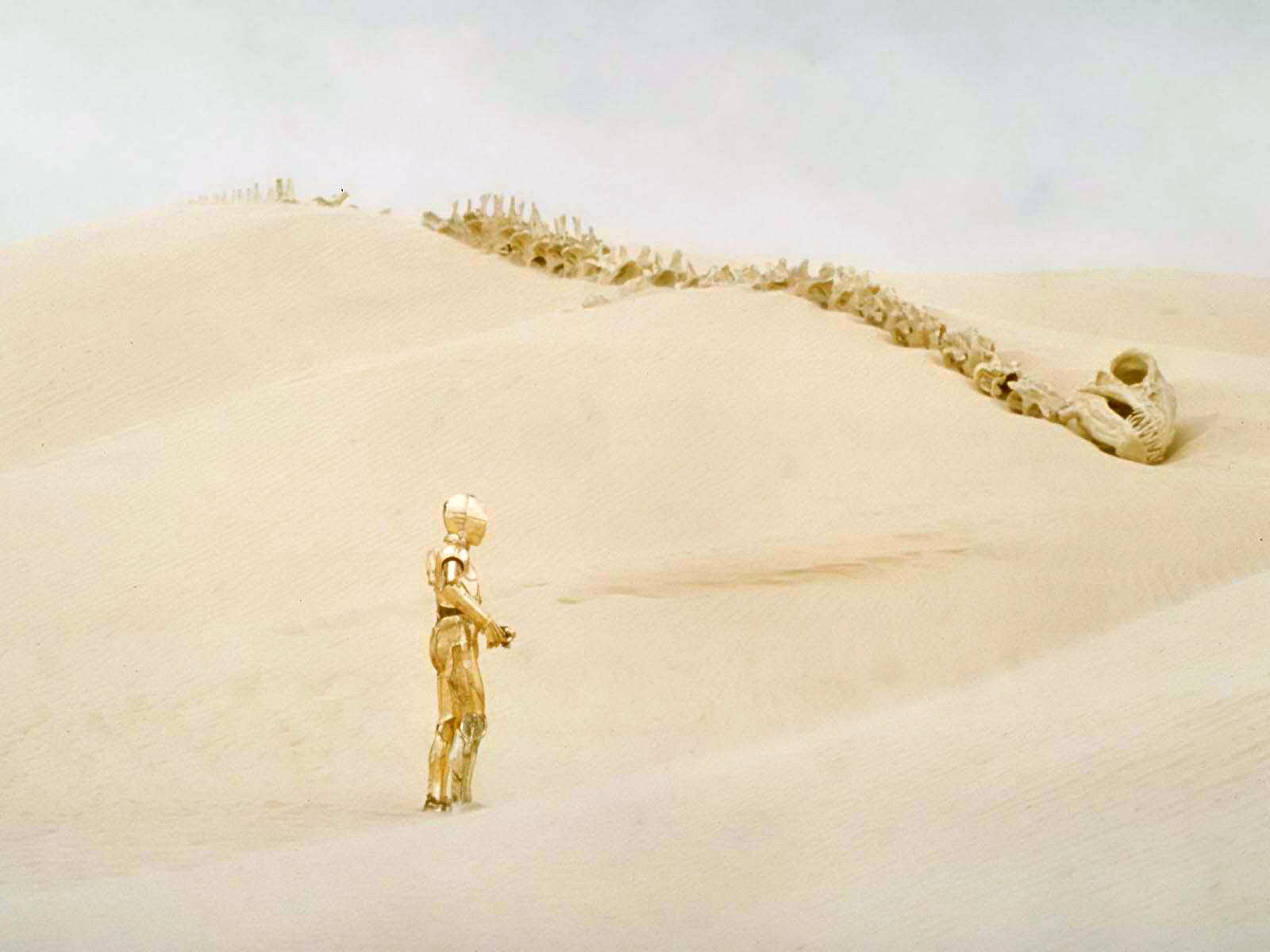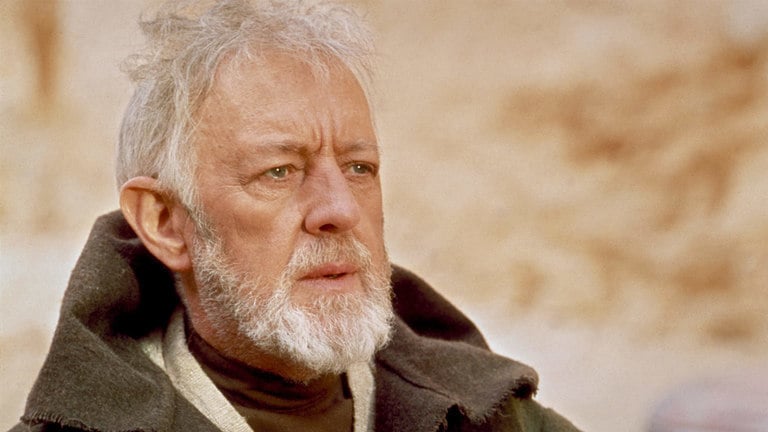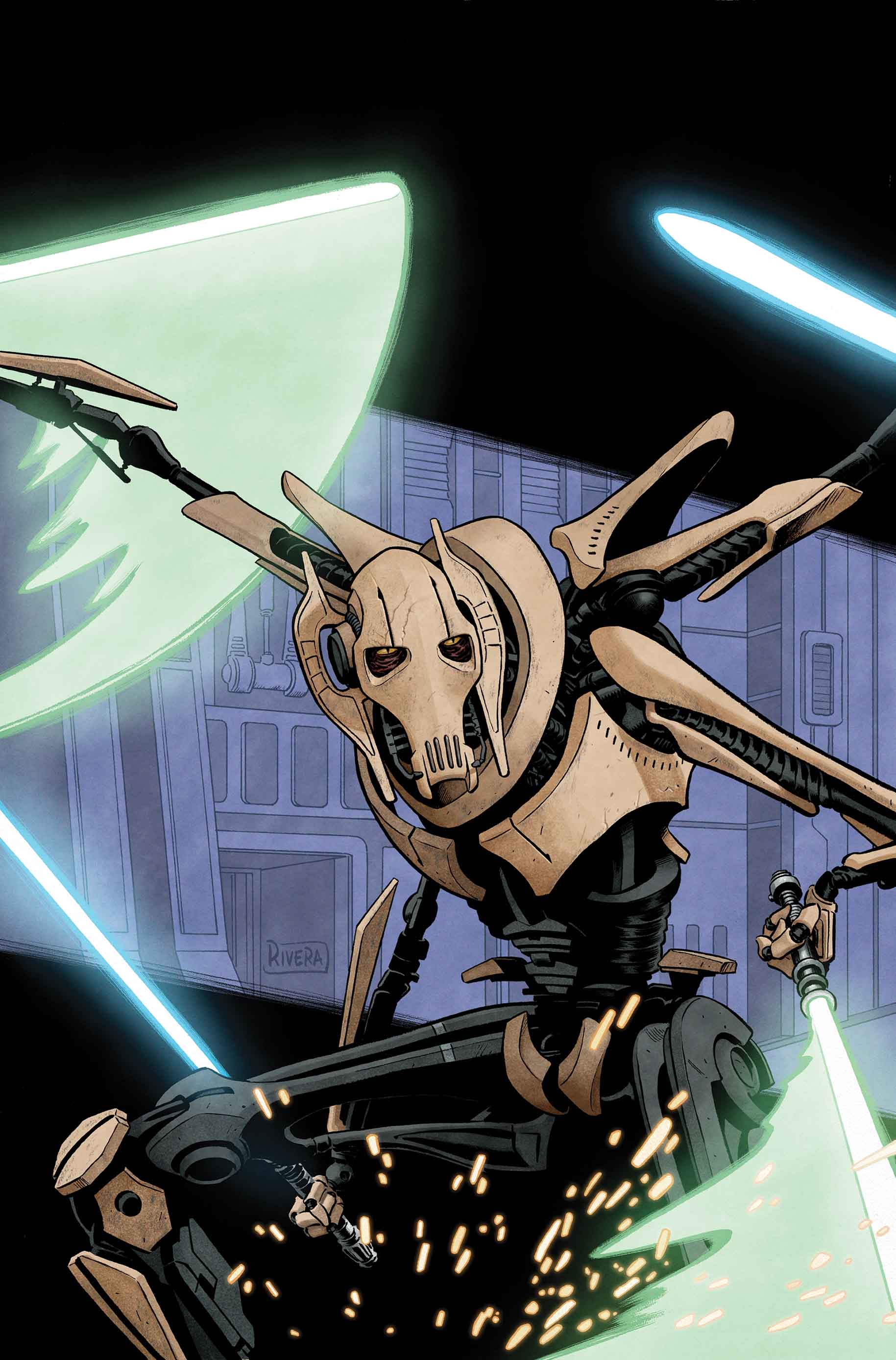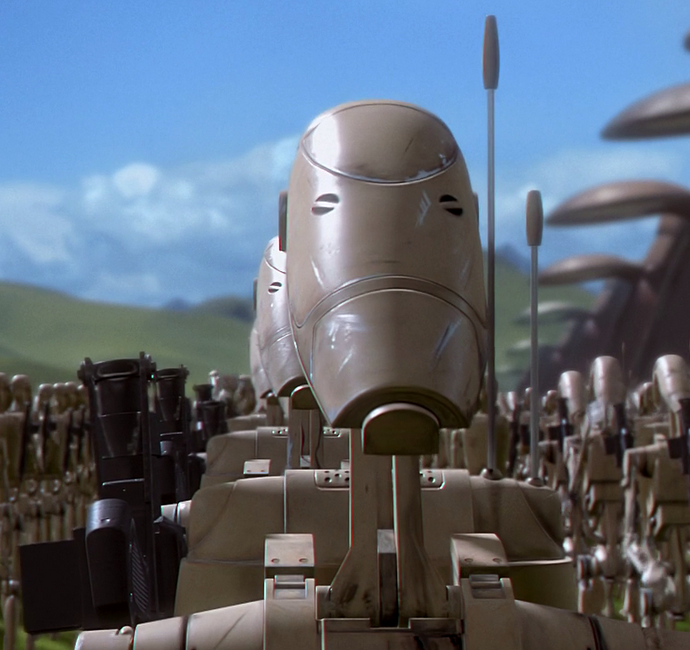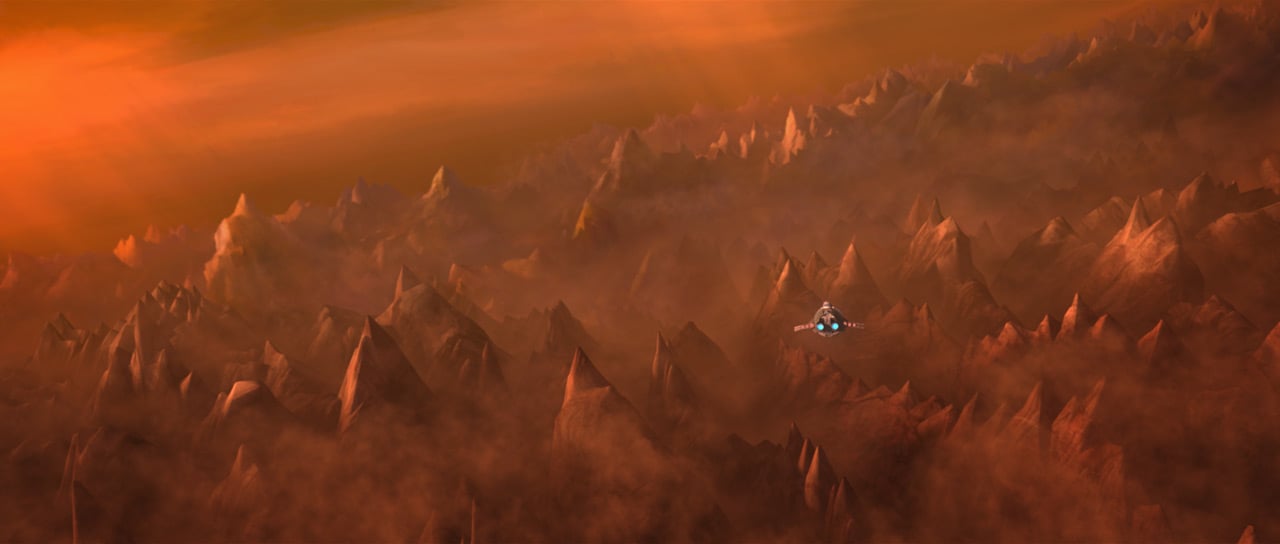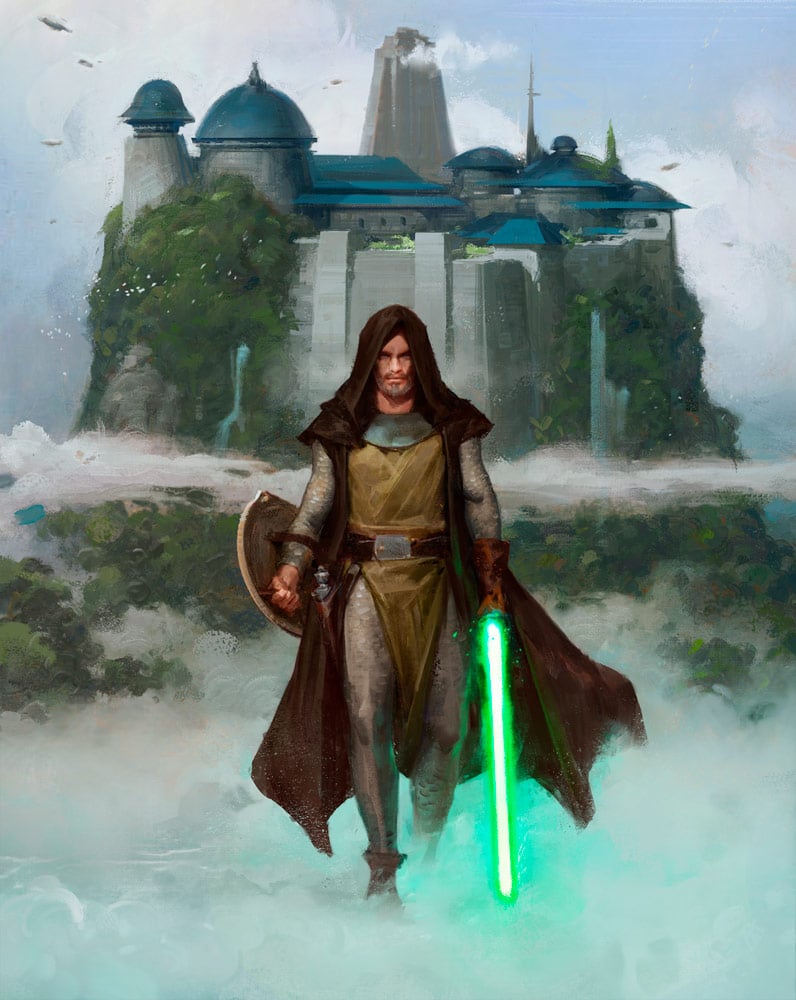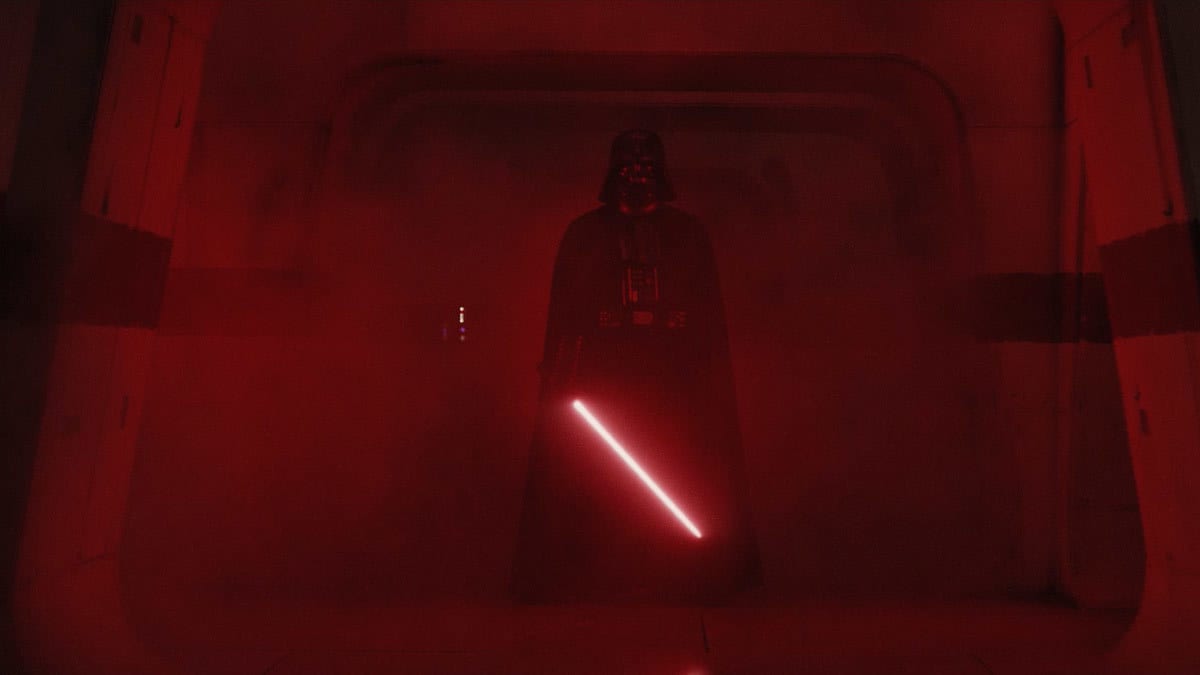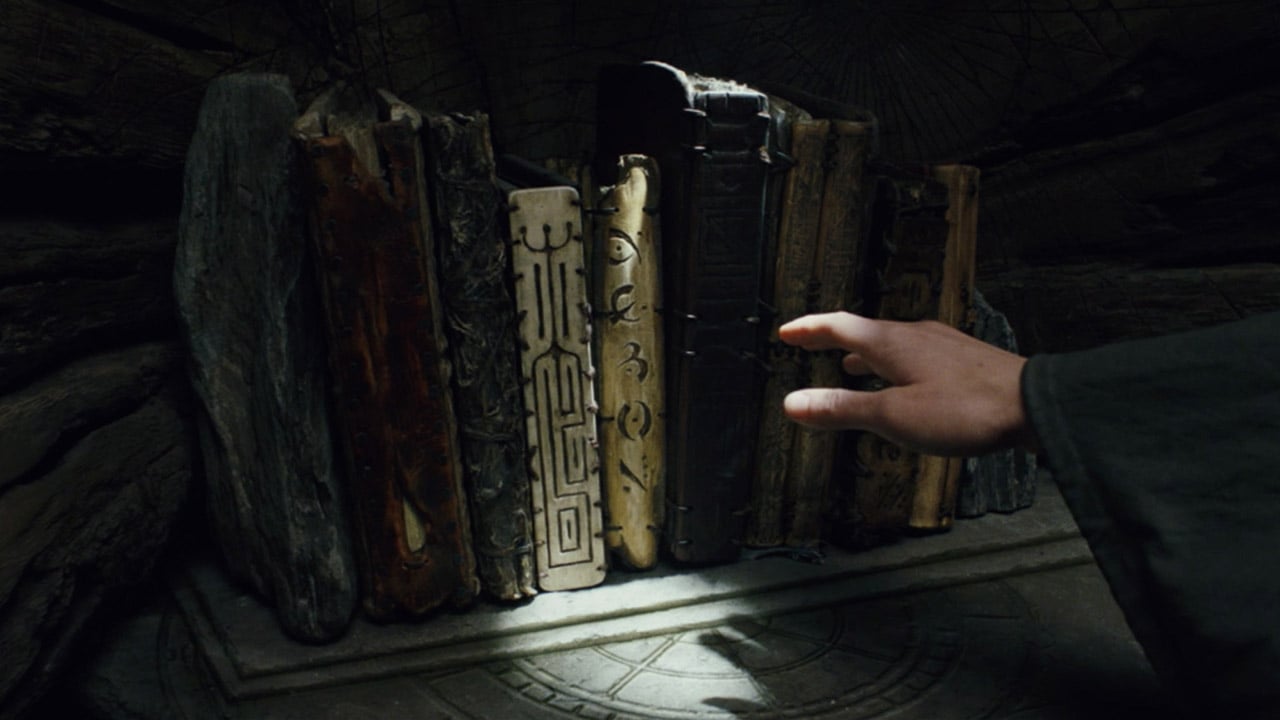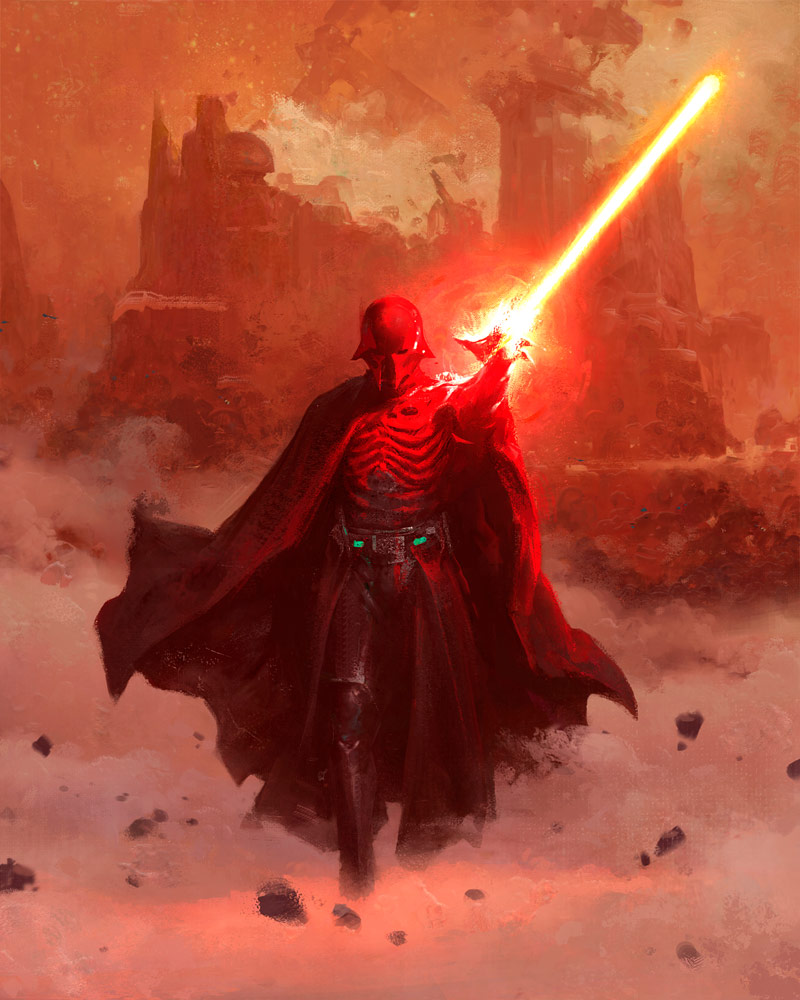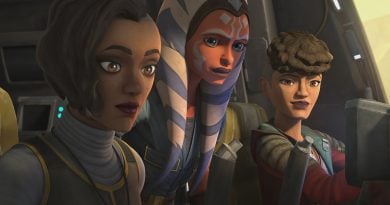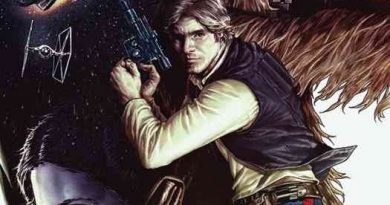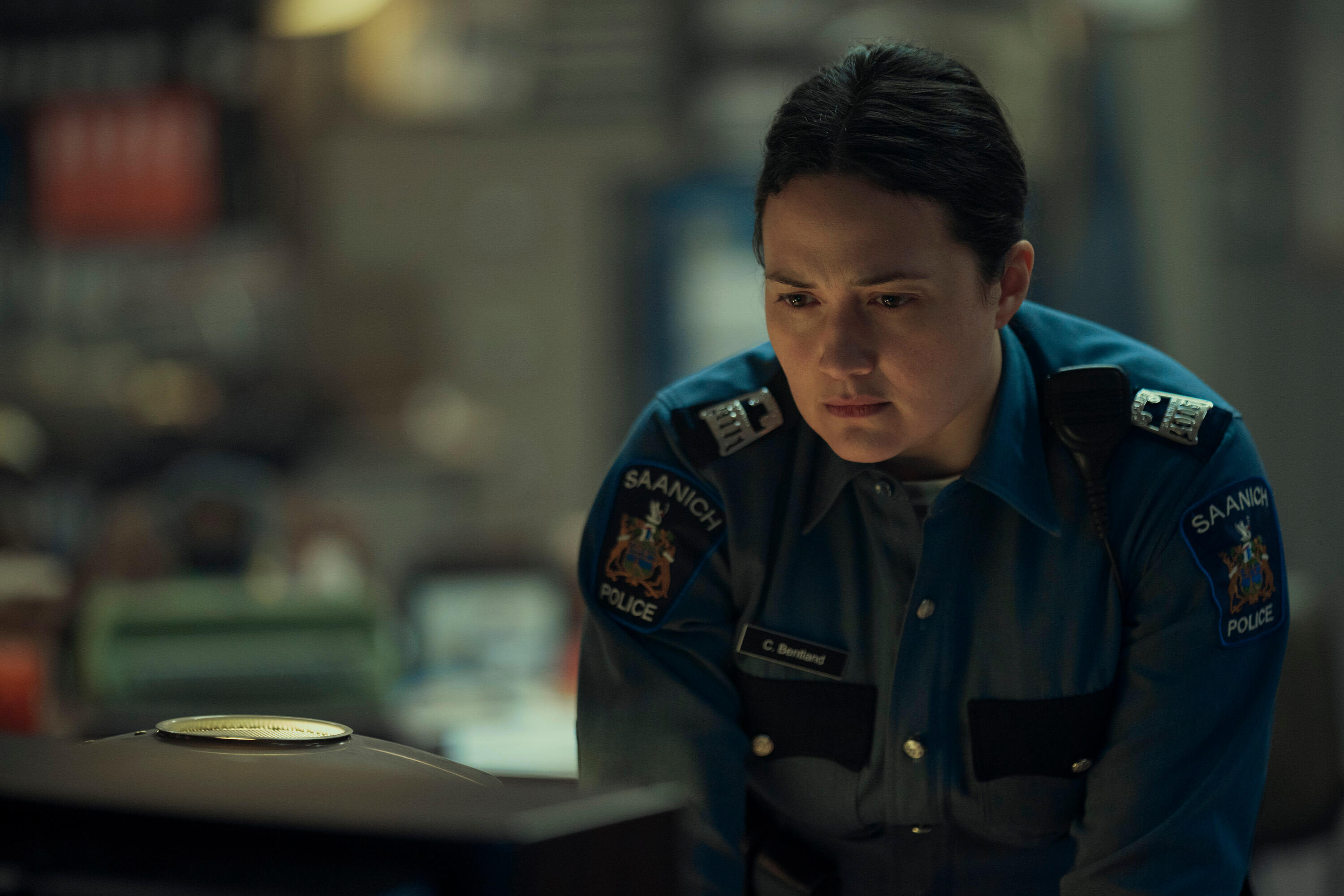Review – There Is Something for Everyone In Star Wars: Myths & Fables by George Mann
If that cover doesn’t sell you then take it from me: Do not sleep on Star Wars: Fables & Myths. Author George Mann has given us an exceptional collection of stories set in the galaxy far, far away. Everything you need to know about the spirit of this book is distilled into a few sentences from its opening pages: “…true power resides not in armies and empires, or in blasters and ancient weapons of light, but in the tales we share with one another”. If you keep that sentiment in mind, you will be greatly rewarded by your time spent amongst some of the folklore told by the campfires of Tatooine and Batuu. This unique volume is a gift to fans and a unique way to immerse yourself in the diverse cultures of the galaxy. The greatest gift to the reader throughout its pages is the audacity to dream and tell stories of your own, no matter if they are for you or for those closest to you. There’s a purity to Mann’s approach and I think Star Wars fans are in for something very special.
One thing I take pride in about Star Wars fandom is our attention to detail. That can apply to a Star Destroyer’s appearance, the color of a lightsaber blade, or the story morsels scattered throughout the canon potentially hinting at bigger stories in the future. Myths & Fables gives us something which transcends the cataloguing of minutiae in the catalog – it gives us a tapestry of stories told by those and for those in the galaxy we often ponder so hard to understand. It’s hard to pin down exactly what this volume of stories tells us about the galaxy, but like us, the everyday children and wide-eyed listeners hearing these stories across the stars look for the same things we do. In this book you will find heroes, villains, scoundrels, and love. Myths & Fables effortlessly captures the grand sentiment we tap into each time we prepare ourselves to see our stories play out across the screen. In the best way, these are Star Wars stories for the residents of Star Wars, so it’s hard not to love each of them for their own contribution.
There are nine stories featured in this collection: “The Knight & The Dragon”, “The Droid With A Heart”, “Vengeful Waves”, “The Wanderer”, “The Black Spire”, “Gaze of Stone”, “The Witch & The Wookiee”, “The Dark Wraith”, and “Chasing Ghosts”. While my survey of them will vary in detail, I’ll try to avoid major spoilers, but I will warn you if you’re looking for hints of how Palpatine returns or Rey’s parentage you will not find that here. These stories carry a weight of their own and certainly connect to the bigger canon, but they are mostly contained within the pages they grace here. Please do not let that dissuade you from reading because Mann’s writing is so worth your time. The writing is not only ornate, the art by Grant Griffin demands to be hung in the halls of Black Spire in Galaxy’s Edge. The collaboration of writing and art is something to behold here. This book is the equivalent of stopping to smell the flowers as you walk down the vast canon of Star Wars. These stories are delicate, fleeting, and lovely. So with that in mind, we are going to proceed and there will be minor spoilers. If you’re looking to go in fresh, stop here and scroll down to my rating.
“The Knight & The Dragon” open the collection and this story is depicted in the above cover work I’ve been drooling over since it was revealed months ago. Because dragons are creatures often associated with ancient, magical aspects of fantasy worlds I assumed this would take place in the distant past of the galaxy with an Old Republic Jedi slaying a lethal dragon. I am happy to report I was dead wrong and the Jedi you see here is Obi-Wan Kenobi and this story takes place on Tatooine between Revenge of the Sith and A New Hope. Though Obi-Wan is never named its certainly him. He’s not named because this tale is told from the perspective of the Tusken Raiders and a Krayt dragon
It’s fair to say we’ve known since 1977 that Krayt dragons roamed the sands of Tatooine, but this story depicts a living one who’s search for food led them to track a tribe of Tusken Raiders. The Tusken Raiders are presented as benevolent nomads, content to live life in the unforgiving sands, finding balance – and ultimately harmony – as they move amongst the winds. I really enjoyed this depiction, which suggests the Tusken culture is much more diverse than we’ve seen on screen and the more aggressive members do not represent the entire race. The sublime balance this tribe of Tuskens found is quickly disrupted when the hungry dragon, named Krayt, begins to snatch up their banthas, one by one. Each day, the dragon appears for its meal, but the real trouble starts when the Bantha flock is depleted. The dragon then turns to feasting on children and other members of the tribe and develops a taste for Tusken flesh. To counter this, the Tusken Raiders turn to raiding settlements and taking prisoners, leaving a prisoner out each day to sate their hunter. The Tusken Raiders know this is wrong but they do this out of desperation, until ‘the old knight’ gets wind of it.
Like I said, this old knight is unmistakably Obi-Wan and we are meeting him much closer to A New Hope than the prequels. Obi-Wan learns of what the Tusken Raiders are doing and allows himself to be captured. He’s aware the Tusken Raiders are acting out of desperation, just as the dragon is acting out of its need to eat. Once Obi-Wan is captured, he frees the other prisoners so that will be the next offering to the hungry dragon. When the dragon appears, Obi-Wan ignites his lightsaber, but he doesn’t attack. The climax of this story is one I’ll leave for you to experience on your own because it’s beautifully written and demonstrates the most admirable qualities of Obi-Wan and the Jedi. I loved how this tale taught mercy and we forget how far sentient beings will go when they are desperate. Obi-Wan was wise enough to look upon the Tusken Raiders as a tribe who just wanted to live in harmony with the land and the dragon as a being who just needed to eat. Neither one knew the pain they inflicted upon the other, so he neutralized both the best way he knew how. It also speaks to the wisdom of the old Jedi and his embrace of pacifism. It further underscores his actions in the Rebels episode “Twin Suns”, when he took mercy on a being so desperate and abused they only knew to turn to their aggression to cope. Despite that person being Obi-Wan’s enemy, the Jedi took mercy, just as he took mercy here where many would not.
And this is just the first tale! The next one is a bit more…grievous.
“The Droid With A Heart” is mildly comparable to the Tin Man’s origin story from The Wizard of Oz, as I first suspected. It’s one-part a General Grievous origin story and one-part a story of the droid soldiers of the Clone War. The origin story of Grievous is much different than the one in canon and Legends, so the reader can decide which of the three they prefer. This tale suggests Grievous held an admiration and fascination for droids because of their strength and abilities, so he slowly started to replace his limbs with droid appendages until he became the cyborg nightmare we meet in Revenge of the Sith. I guess it’s similar to the Tin Man chopping off his limbs, but the suggestion Grievous considered his cyborg-state one of perfection is fascinating. Despite his admiration for the droid design, Grievous’ underlings are confounded by his disregard for them, while he sends them into doomed battles and sacrifices thousands.
Up until this point, I’d always looked at the battledroids more like a hive-esque mind, despite the glimpses we get of their individualism in the prequel trilogy and The Clone Wars. The droids are terrified of Grievous and they are terrified of dying. One small tactical droid finally stands up to Grievous by not carrying out his orders, thus saving many droids lives but dealing a blow to the Separatists. I’m sure you can guess what happens to the brave little droid when Grievous learns of the defiance, but what comes after is the most touching part. The battledroids gather its remains and try to reconstruct it. When they can’t, they keep its memory alive by sharing stories of its bravery amongst each other. I love the agency and autonomy droids have been given in the Star Wars universe the last few years. This reminded me of the one-shot issue C-3PO, about his red arm in The Force Awakens and the meaning behind it – saving a droid who’d sacrificed themself to save other droids. Sign me up for more droid stories because the reflection on existentialism in a galaxy where they are still treated as sub-sentients promises great storytelling.
From the familiar characters, we then weave our way across the galaxy in Myths & Fables. In “Vengeful Waves”, a cautionary story taking place on ancient Glee Anselm about a symbiotic relationship between its two species, the Anselmi and the Nautolans (Kit Fisto) ruined by greed with consequences that forever alter their planet and society. “The Black Spire” tells the tale of a heroic little girl who finds strength and courage within herself to rescue her siblings from a slaver on Batuu. “The Witch & The Wookiee” tells a tale of a Force mystic using the greed of pirates against them, while teaching them a lesson at the same time. “Chasing Ghosts” is about a con-man on Batuu who shares his own elaborate tale about a mysterious bounty hunter who may or may not have existed.
“Gaze of Stone” was one of my favorites. It tells the story of a stone Twi’lek statue on Moraband, which has become legendary in the Sith. Many of the Sith have made up their own mythology around the statue, speculating that it was either a powerful Sith Lord or someone who’d fallen. It’s a dark and arresting story about how the Sith recruited some apprentices as children. Darth Caldoth (who is mentioned in Cavan Scott’s audio-drama Dooku: Lost Jedi) takes on a Twi’lek child as an apprentice, named Ry Nymbis. If the Sith weren’t so evil, their stories would certainly be worth calling tragedies as Sheev refers to the tale of his deceased master – because this story is very tragic. From a misunderstood child, Ry Nymbis is brutalized and manipulated by Caldoth to fulfill the ultimate destiny of a Sith Apprentice: challenge the master. To avoid major spoilers, I’ll leave out the end, but it certainly adds an undercurrent of sadness to the maliciousness in the dark side’s complete consumption of those who stray from the light.
The two tales I haven’t discussed yet are connected, “The Wanderer” and “The Dark Wraith”. “The Wanderer” depicts a Jedi who aids a city on the planet Cerosha, showing up each time whenever they need help. He protects them from several different calamities, each time disappearing but eventually returning as soon as he’s needed. The people of Cerosha don’t call him a Jedi, referring to him as the Wanderer with his “sword of light“. Eventually, the Wanderer vanishes and he’s replaced by the Dark Wraith. “The Dark Wraith” clearly describes Darth Vader, but the people of Cerosha only know him as the shadow of darkness rather than the Dark Lord of the Sith. The Cerosha are people removed from the events churning the galaxy in violent civil war, so they look to the Wanderer for hope and the Dark Wraith for fear and retribution.
The Dark Wraith is presented as a mythological boogeyman, half-jokingly invoked by parents trying to get their kids to obey. While this far removed view of Vader occurs throughout the story, it also suggests there is a reason Vader’s presence is even known. One of the local legends tells of him stealing away a child in the night who may have been Force sensitive, but the Cerosha have no knowledge of the Force, so they just assumed she was misbehaving. It’s very disturbing to think Vader and his Inquisitors went around the galaxy, culling Force sensitive children, and were seen as demigods, even if they were to be feared. There’s also a description of Vader wiping out an entire city on Cerosha, while the people blamed themselves but secretly hoped the Wanderer would return to save them. “The Dark Wraith” ends in hopelessness, with the population of Cerosha docile and left only with the tale of the one who’d protected them before the Dark Wraith emerged. Unfortunately, Vader’s legend reinforces that no one’s ever really gone is a very double-edged sentiment.
The ambiguity of Myths & Fables may frustrate some fans, but I say embrace it. We are about to be hit with a flood of new books this fall and winter, filled with stories that no doubt contain technical details or hints about more prominent characters’ stories. Myths & Fables is uniquely suited for the reader who just wants to sit back and take in a good story while not worrying about how it fits into the rest of the canon. At the same time, all of these could fit into the canon, but their status being fluid lets the reader let go and soak up the stories. This book is very special in the simplicity of how you can take these tales to mean whatever you want them to. If you don’t like the idea of Obi-Wan dueling with a dragon in the deserts of Tatooine…fine, then it didn’t happen and it’s just a myth or fable. If that’s something you want as canon, great, Obi-Wan did it and is the hero we always knew. The point I’m trying to make is George Mann presents these stories to you without any expectations, decorated elegantly with his writing, and you can choose to accept them as canonical truth or just let them fade into legend. That, dear reader, is your prerogative.
Artist Grant Griffin contributed some of the best art I’ve seen in Star Wars so far. My only complaint is I wish we had a few more in the actual text of the story. I hope we all start clamoring to Lucasfilm for more of his work going forward. I’d buy a whole book of his artwork. It sets the tone and compliments Mann’s writing perfectly. Each story has a dedicated piece, which is satisfactory, but like I said, I wish there had been more. The vivid, dreamlike colors really help the reader get in the mood for each tale.
I highly recommend Myths & Fables. Star Wars magic is far from gone and this franchise feels fresher than ever, but Myths & Fables stirred up my imagination with a ferocity I didn’t expect. I felt like a kid again, up past my bedtime, hiding under my blankets with a flashlight trying to get to the next page of whatever book or comic I was reading. There is a sense of wonder this book conveys which is so special and unique to each reader I dare not try to put it into words. Think about the stories you told your friends, or the ones they told you. Think of the people in your life you looked up to, hoping to gleam a little bit of what you knew made them special, and hoping they’d tell you a story about what made them that way. This isn’t necessarily a book about our heroes in Star Wars, but it is a book about what makes them our heroes. Don’t miss this one.
RATING: 9/10
Star Wars: Myths & Fables is available at your local bookstore and online retailers. Special thank you to Disney Lucasfilm Publishing for the advanced copy used in this review.
Kyle Larson lives in Portland, Oregon. When he's not running trails, he's reading and writing.

